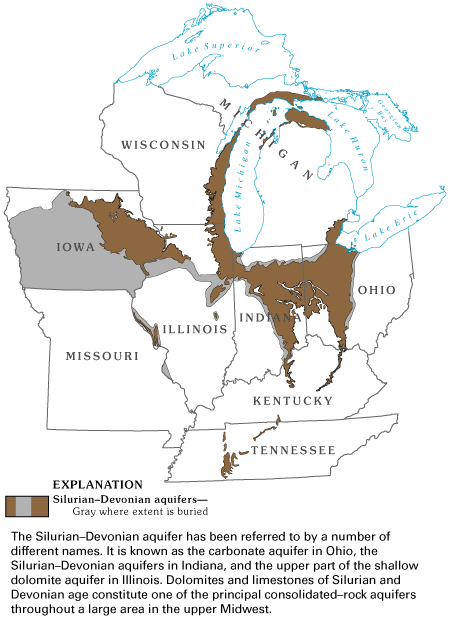Carbonate-rock aquifers are most extensive in the eastern United States. Most of the carbonate-rock aquifers consist of limestone, and their water-yielding properties vary widely.
To learn more, visit the Carbonate-Rock Aquifers webpage for an overview, or access more extensive information from the Ground Water Atlas of the United States (USGS Hydrologic Atlas 730) by clicking on an individual region/chapter below.
Basin and Range carbonate-rock aquifers (southwestern U.S.)

- California, and Nevada (Chapter B)
- Arizona, Colorado, New Mexico, and Utah (Chapter C)
Roswell Basin aquifer system (New Mexico)

- Arizona, Colorado, New Mexico, and Utah (Chapter C)
Blaine aquifer (Oklahoma and Texas)

-
Oklahoma and Texas (Chapter E)
Arbuckle-Simpson aquifer (Oklahoma)

-
Oklahoma and Texas (Chapter E)
Silurian-Devonian aquifers (northern Midwest)

- Illinois, Indiana, Kentucky, Ohio, and Tennessee (Chapter K)
- Iowa, Michigan, Minnesota, and Wisconsin (Chapter J)
Ozark Plateaus aquifer system (Missouri)

- Kansas, Missouri, and Nebraska (Chapter D)
- Arkansas, Louisiana, and Mississippi (Chapter F)
- Oklahoma and Texas (Chapter E)
Ordovician aquifers (Tennessee and Kentucky)

-
Illinois, Indiana, Kentucky, Ohio, and Tennessee (Chapter K)
Upper carbonate aquifer (Minnesota and Iowa)

-
Iowa, Michigan, Minnesota, and Wisconsin (Chapter J)
Floridan aquifer system

-
Alabama, Florida, Georgia, and South Carolina (Chapter G)
Biscayne aquifer (Florida)

-
Alabama, Florida, Georgia, and South Carolina (Chapter G)
New York and New England carbonate-rock aquifers

Piedmont and Blue Ridge carbonate-rock aquifers (eastern U.S.)

-
Delaware, Maryland, New Jersey, North Carolina, Pennsylvania, Virginia, and West Virginia (Chapter L)
Castle Hayne-Aquia aquifer (North Carolina)

-
Delaware, Maryland, New Jersey, North Carolina, Pennsylvania, Virginia, and West Virginia (Chapter L)
North Coast Limestone aquifer system (Puerto Rico)

Kingshill aquifer (Virgin Islands)

Below are other web pages related to principal aquifers.
Carbonate-rock aquifers
Below are publications associated with principal aquifers.
Ground Water Atlas of the United States
Carbonate-rock aquifers are most extensive in the eastern United States. Most of the carbonate-rock aquifers consist of limestone, and their water-yielding properties vary widely.
To learn more, visit the Carbonate-Rock Aquifers webpage for an overview, or access more extensive information from the Ground Water Atlas of the United States (USGS Hydrologic Atlas 730) by clicking on an individual region/chapter below.
Basin and Range carbonate-rock aquifers (southwestern U.S.)

- California, and Nevada (Chapter B)
- Arizona, Colorado, New Mexico, and Utah (Chapter C)
Roswell Basin aquifer system (New Mexico)

- Arizona, Colorado, New Mexico, and Utah (Chapter C)
Blaine aquifer (Oklahoma and Texas)

-
Oklahoma and Texas (Chapter E)
Arbuckle-Simpson aquifer (Oklahoma)

-
Oklahoma and Texas (Chapter E)
Silurian-Devonian aquifers (northern Midwest)

- Illinois, Indiana, Kentucky, Ohio, and Tennessee (Chapter K)
- Iowa, Michigan, Minnesota, and Wisconsin (Chapter J)
Ozark Plateaus aquifer system (Missouri)

- Kansas, Missouri, and Nebraska (Chapter D)
- Arkansas, Louisiana, and Mississippi (Chapter F)
- Oklahoma and Texas (Chapter E)
Ordovician aquifers (Tennessee and Kentucky)

-
Illinois, Indiana, Kentucky, Ohio, and Tennessee (Chapter K)
Upper carbonate aquifer (Minnesota and Iowa)

-
Iowa, Michigan, Minnesota, and Wisconsin (Chapter J)
Floridan aquifer system

-
Alabama, Florida, Georgia, and South Carolina (Chapter G)
Biscayne aquifer (Florida)

-
Alabama, Florida, Georgia, and South Carolina (Chapter G)
New York and New England carbonate-rock aquifers

Piedmont and Blue Ridge carbonate-rock aquifers (eastern U.S.)

-
Delaware, Maryland, New Jersey, North Carolina, Pennsylvania, Virginia, and West Virginia (Chapter L)
Castle Hayne-Aquia aquifer (North Carolina)

-
Delaware, Maryland, New Jersey, North Carolina, Pennsylvania, Virginia, and West Virginia (Chapter L)
North Coast Limestone aquifer system (Puerto Rico)

Kingshill aquifer (Virgin Islands)

Below are other web pages related to principal aquifers.
Carbonate-rock aquifers
Below are publications associated with principal aquifers.


